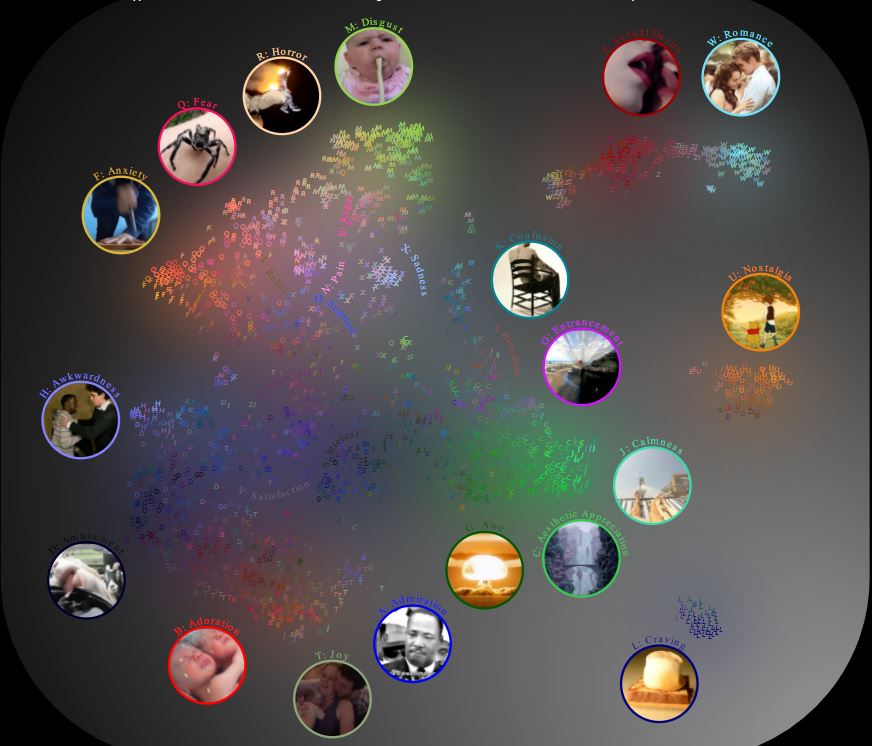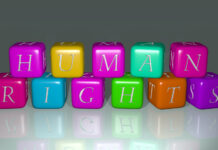New research conducted by Alan S. Cowen and Dacher Keltner at the University of California, Berkeley, challenges the notion that people experience only a handful of distinct emotions. Their research – designed to better capture subjective experiences of feeling – identifies 27 categories of emotional experiences, separated by fuzzy rather than discrete boundaries.
“We wanted to shed light on the full palette of emotions that color our inner world,” Cowen said in a press release.

Longstanding theories have categorized emotional experiences as raw, disconnected categories varying in valence and arousal, or into discrete states, such as those universally clustered into happiness, sadness, anger, fear, disgust, and surprise. Researchers at the University of California, Berkeley, have recently called attention to the limitations of these approaches as their findings suggest an alternative conceptual framework.
“Despite the pervasive influence of these theoretical approaches, empirical progress in understanding how reported emotional experiences are organized within a semantic space has been modest.”
Cowen and Keltner sought to further investigate the scope, range, and boundaries that accurately describe emotional categories. Namely, they questioned (a) “How many distinct varieties of emotion do people reliably report experiencing across distinct situations?” (b) “Is reported emotional experience better understood in terms of categories, such as amusement and awe, or in terms of widely measured affective dimensions, such as valence and effort?” (c) “Do boundaries between emotion categories such as amusement and awe correspond to discrete jumps or smooth transitions in how emotions are reported to be experienced?”
Cowen and Keltner collected data on the emotional states people reported experiencing when watching the largest collection—over 2,000 short, emotionally evocative video clips—of “psychologically significant situations” ever studied. The videos were retrieved using Amazon Mechanical Turk.
Participants included 853 English-speaking, U.S. participants (450 males, 403 females, mean age = 36) divided into three different groups. The first group freely rated their emotional experiences to each of 30 videos without any formal assessment procedure. The second group also responded to each of 30 videos by choosing from a list of 34 emotion categories derived from previous theory. The final group rated 12 videos along 14 widely measured scales frequently used to measure emotional dimensions.
While acknowledging the built-in assumption in using self-report measures, Cowen and Keltner also cite previous research noting that measuring subjective experiences, such as emotions, are most accurately achieved through self-report. Most notably, however, the methods used assume that reported accounts of people’s emotional experiences accurately correspond to the language used to communicate that experience.
Pulling from mathematically-based conceptual frameworks, the researchers used multiple methods to analyze over 324,000 individual responses to the video clips depicting births and babies, weddings and proposals, suffering and death, spiders and snakes, endearing animals, art and architecture, natural beauty and wonders, natural disasters, explosions and warfare, feces and vomit, sexual acts, nostalgic films, awkward handshakes, soldiers returning home, and many others.
“The 27 dimensions we derive from emotion self-report in response to short videos demonstrate a semantic space of emotions far richer in distinct varieties of reported experience than anticipated by emotion theories to date,” Cowen and Keltner write.
The researchers found that 27 categories of emotion were reliably reported across participants. However, their findings support a more complex picture of emotions in that these unique emotion categories were linked to other emotions through continuous gradients, rather than representing separate, distinct clusters.
“Although reported emotional experiences are represented within a semantic space best captured by categorical labels, the boundaries between categories of emotion are fuzzy rather than discrete.”
These findings challenge previous theories which have posited that experiences of emotion are either simply clustered or simply uniform. Instead, Cowen and Keltner highlight links between experiences of admiration, awe, and aesthetic appreciation or between fear, horror, and disgust, arguing for a model of discrete clusters connected by continuous gradients.
“While each category is associated with a specific pattern of affective dimension ratings, these ratings do not shift abruptly across categories; rather, they vary smoothly along the gradients associated with each emotion category.”
These thought-provoking findings have compelling implications for reframing research, education, and practice in the field. In addition to this, however, it is important to recognize how this study relies on the notion that it is possible to accurately depict one’s subjective experience through self-report. These findings also focused on commonalities across individuals’ experiences, rather than differences, and only sampled English-speaking Americans.
“By no means do we mean to claim that this is the definitive taxonomy of emotional states, for which studies of other types of stimuli, other approaches to self-report, other modalities of emotional response, and other cultures will need to be incorporated. Nevertheless, the present investigation reveals the rich varieties of reliably reported emotional experience that may shape human behavior.”
**
The researchers organized their findings using visualization techniques into a colorful display of the 27 emotional experiences. The censored version of this map can be viewed here. The uncensored version (NSFW, 18 years and older, and accessed at your own discretion) can be viewed here.
****
Cowen, A. S., & Keltner, D. (2017). Self-report captures 27 distinct categories of emotion bridged by continuous gradients. Proceedings of the National Academy of Sciences, 114(38), E7900-E7909. (Link)















Ask people from different cultures and you’ll get even more variety.
https://en.wikipedia.org/wiki/Theory_of_constructed_emotion
Report comment
The algorithm to tell them when to interrupt.
To remind me that there are pills for that emotion.
They already know what you think, they’re working on how you feel – so that they can hit the sweet spot every time! And “correct” the sour spots.
This is some scary stuff when you look at the long term marketing / control implications of this technology!
Report comment
Science has lost its way: anything can now pass. Parsimony is the most basic principle of science: fewer assumptions make better science. Hence, the most basic principle of the philosophy of science is falsifiablility: a science theory must identify its assumptions by explaining how to disprove itself. This “science” makes so many assumptions that it is pure philosophy; prestigious science journals now let any philosophy pass for science.
Report comment